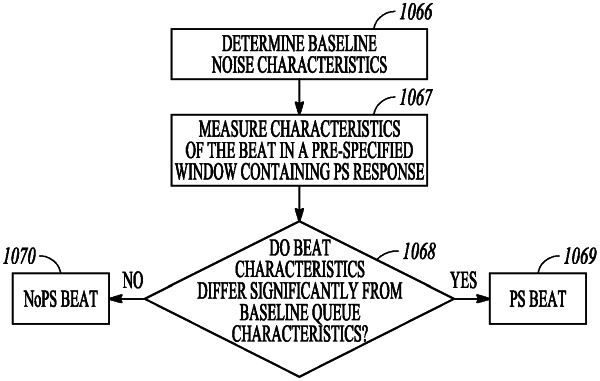| CPC A61B 5/24 (2021.01) [A61B 5/0205 (2013.01); A61B 5/1107 (2013.01); A61B 5/4052 (2013.01); A61B 5/686 (2013.01); A61B 5/7221 (2013.01); A61B 5/7246 (2013.01); A61N 1/36542 (2013.01); A61N 1/371 (2013.01); A61B 5/7217 (2013.01); A61B 2562/0219 (2013.01)] | 20 Claims |

|
1. A method for detecting phrenic nerve stimulation (PS) beats, wherein the PS beats are cardiac paces that induce phrenic nerve stimulation, the method comprising:
using morphological features for a sensed beat signal to determine if the sensed beat signal is a PS beat, wherein using the morphological features to determine if the sensed beat signal is a PS beat includes at least one of:
analyzing the identified morphological features using weight-based scoring of the identified morphological features, wherein weight-based scoring weights some morphological features differently when determining if the sensed beat signal is the PS beat;
analyzing the identified morphological features using a decision tree to determine if the sensed beat signal is the PS beat; or
scoring morphological features of the sensed beat signals, using the score to identify those sensed beat signals that can be declared PS beats with a high degree of confidence and those sensed beat signals that can be declared NoPS beats with a high degree of confidence and identify those sensed beats that cannot be declared with the high degree of confidence as either a PS beat or a NoPS beat, and correlating those sensed beats that cannot be declared with a high degree of confidence to a PS template, and declaring the sensed beats that are correlated with the PS template to be a PS beat.
|
|
8. A method, comprising:
detecting pace-induced phrenic nerve stimulation using a sensed physiological signal, wherein the pace-induced phrenic nerve stimulation is phrenic nerve stimulation induced by at least one cardiac pace, wherein the detecting pace-induced phrenic nerve stimulation includes:
sampling the sensed physiological signal that is used to detect pace-induced phrenic nerve stimulation during each of a plurality of cardiac cycles to provide a plurality of sampled signals corresponding to the plurality of cardiac cycles, wherein sampling the sensed physiological signal includes:
identifying a window for each of the cardiac cycles to avoid cardiac components and phrenic nerve stimulation components; and
sampling the sensed physiological signal that is used to detect pace-induced phrenic nerve stimulation during the window to provide sampled signals, wherein the sampled signals during the window do not have cardiac components and phrenic nerve stimulation components;
calculating a baseline level for the sensed physiological signal that is used to detect pace-induced phrenic nerve stimulation using the plurality of sampled signals corresponding to the plurality of cardiac cycles; and
detecting pace-induced phrenic nerve stimulation using the sensed physiological signal and the calculated baseline level; and
changing a pacing configuration for pacing the heart in response to detected pace-induced phrenic nerve stimulation.
|
|
14. A method, comprising:
testing for phrenic nerve stimulation (PS) threshold, including:
pacing a heart with a cardiac pace at a pacing output level;
sensing a physiological signal for use in detecting a PS beat, wherein the PS beat is a cardiac pace that induces phrenic nerve stimulation; and
monitoring for a PS beat in the sensed physiological signal to detect if the pacing output level caused the PS beat;
if the PS beat is detected at the pacing output level, analyzing the detected PS beat using criteria to determine if the pacing output level can be declared to be the PS threshold; and
if the pacing output level cannot be declared to be the PS threshold based on the analysis of the PS beat at the pacing output level, performing a PS beat confirmation procedure including:
delivering another cardiac pace at the pacing output level to generate an additional PS beat, and analyzing the additional PS beat using other criteria to determine if the pacing output level can be confirmed as the PS threshold; or
changing the pacing output level, delivering another cardiac pace at the changed pacing output level, and analyzing the sensed physiological signal at the changed pacing output level using criteria to determine if the pacing output level can be confirmed as the PS threshold.
|